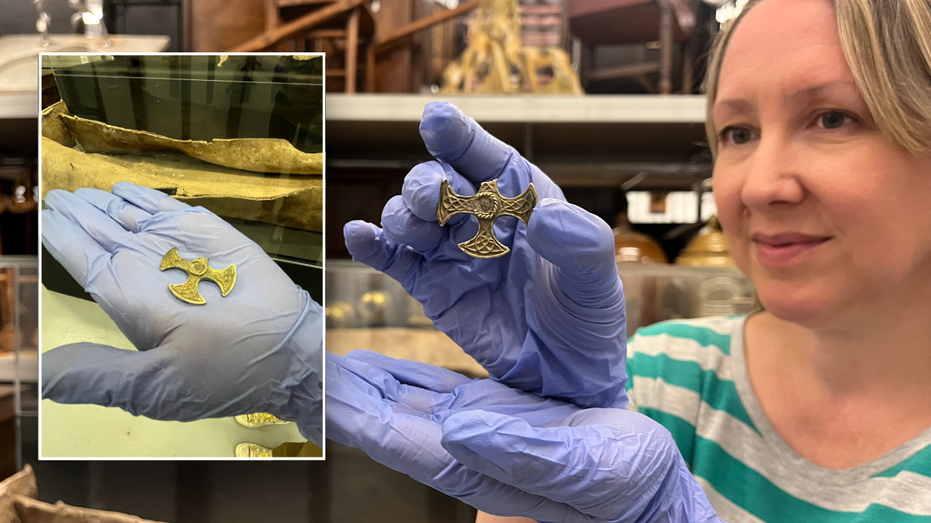- by foxnews
- 25 May 2025
‘Everything’s going to pieces’: how a port took over a Black US neighborhood
‘Everything’s going to pieces’: how a port took over a Black US neighborhood
- by theguardian
- 25 Mar 2022
- in news

At age 97, Henry Jones is preparing to move out of the house he called home for more than 70 years, a modest dwelling he built in Freeport, Texas. The exterior is a cool, teal color; the interior walls are lined with family memorabilia and intricate wooden detail. This, he says, is where the best memories of his life have taken place.
The process of leaving, however, has made for some of the worst. Jones is one of the final residents of the city's East End, a historically Black neighborhood that became encircled by industry throughout the 20th century, much of it related to Port Freeport. Like many residents in the neighborhood, Jones's relationship to the port has evolved over time: when he was younger, he took shifts loading and unloading ships, work he says was hard but helped him provide for his growing family.
Now, the port is no longer Jones's employer but is in the process of acquiring his land against his will, utilizing its status as an independent governmental body to lay claim to the land he built a life on.
The majority of his friends and neighbors are already gone; as of October 2021, Port Freeport claimed to have obtained 95% of property in the East End as part of an extensive expansion plan.
"What I accumulated, I thought I would enjoy it and my family [would] inherit it," Jones says. "Now, everything's going to pieces while I'm here."
Many former East End residents echo Jones's upset at the way their community has been displaced - churches, businesses and homes - in a way some describe as systematic. The methods the port has used, including eminent domain and house "swaps", are the subject of ongoing legal disputes.
But the displacement happening in East End today is also just the latest chapter in a long history of Black land dispossession that has taken place in Freeport. In 1930, Freeport established East End as a "Negro reservation", requiring all Black residents to live there, with the exception of those who were servants to white families. When he first arrived in 1949, Jones remembers the neighborhood had no adequate sewage system, no paved roads.
In the years that followed, neighbors helped build each other's homes and businesses until it was possible to get the food you needed, the haircut you wanted, and send your children to church all within walking distance.
The city never did pave those roads, but a real community formed in the East End, and Jones's house became a home, lively and full, with four children and a backyard garden with chickens.
The story of how the East End was dismantled, bit by bit, is also part of a much larger tale of how marginalized communities are often sacrificed in the US to make way for industry. In that process, families like Jones's are stripped of the generational wealth they believed a lifetime of work would earn; the American dream, as it had been described to them.
Port Freeport was established in 1925, bringing a wealth of new jobs to an area that, at the time, was largely centered around the Stauffer Chemical Company.
Over decades, it grew to generate billions of dollars in economic activity each year, attracting a roster of big businesses like Dole and petrochemical companies like Phillips 66. More residents moved in, as well, and the East End became more diverse, with a large Hispanic population.
Today it is one of the largest water ports in the US, ranked 31st largest in terms of annual tonnage by the army corp of engineers in 2017. And it's set to get even bigger. In 2014, Congress authorized a project to deepen and partially widen the Freeport Harbor Channel - which, once completed, would allow the port to accommodate bigger vessels.
As part of the expansion project, the port has said it needs to acquire the land that East End is built on. In an op-ed published last year, the port's CEO, Phyllis Saathoff, framed the acquisition as integral to the project, saying it would "facilitate additional international commerce and allow for the efficient management of truck traffic, reducing both congestion and emissions".
Saathoff has also stated the port only started buying up East End land in 1999. But former and current residents say they remember the port's encroachment starting earlier.
One former East End resident, Lila Mae Lloyd, has a folder of newspaper clippings that she says chart the port's actions over the years, including examples of creeping acquisitions away from the coast. In the 1990s, that included a land swap with two businesses, foreshadowing what was to come for some East End residents.
Sisters Edmeryl and Angie Williams say they first heard about the port's plans to buy up their neighborhood when they were in high school - they're now in their 60s. And while the port did not authorize using eminent domain there until 2019, residents voiced concerns about their homes being taken through this process at Freeport city council meetings as early as 2016.
For Robert Koole, the first sign of trouble came from the city of Freeport, rather than the port itself. After moving back to his childhood home in 2018, Koole says the city repeatedly denied his permit requests to make structural improvements. Similar complaints from other East End landowners and residents are a part of a Title VI complaint against Port Freeport and the city of Freeport for racial discrimination.
"The relative value of [those properties] dropped based on the lack of city services," says Amy Dinn, of Lone Star Legal Aid, who is representing the residents. "You can see how [the defendants] were systematically trying to remove the homes from the East End or devalue them."
The complaint, originally filed in 2017, cycled through the court system for years before being picked up by the Biden administration's Department of Homeland Security for review to determine whether the agency will pursue an investigation.
City officials representing the East End did not respond to the Guardian's request for comment. However, Freeport's mayor, Brooks Bass, and city manager, Tim Kelty, released a statement on the port's use of eminent domain in the city last year, saying in part that the city has tried to "convince" the port to "develop elsewhere" rather than the East End.
Koole was eventually able to secure the permits and install a new fence and siding to his home. Still, there were other neighborhood issues, like potholes in the road, that he says the city continued to ignore. The onset of the pandemic in 2020 was the final straw - Koole accepted an eminent domain offer that he expects will be less than $100,000 once it is divided up with the other property heirs. He's now living with his sister, so far unable to find a new place of his own that he can afford.
"I would've been happy to live in that house the rest of my life - small community that I grew up in, it's near the beach," Koole says. "Everything that I wanted, right there."
Not everyone who sold their home to the port is unsatisfied. Jessie Parker grew up in the East End and moved back as an adult, in part to fight for her family home. For years, she was a regular in city council meetings, speaking out about the conditions in the East End and what she described as harassment from the port. Then, she says she received an offer from the port "she couldn't refuse". In December, she attended a council meeting with a different message - thanking the mayor for helping with her settlement.
Others who made deals with the port - including residents who agreed to "swap" deals - have returned to the council with new complaints. More than three dozen households accepted offers to trade their East End homes for port-owned and developed properties, most located a few miles away, according to the port and the Title VI complaint.
As the complaint lays out, some who made the swap say their new houses have been plagued by issues, including improper drainage, and that residents did not necessarily receive the features they were promised. It also alleges that multiple houses are located in a 100-year floodplain, which is of particular concern given the coastal location - this past summer, the area was hit by Hurricane Nicholas. The East End is the highest area in Freeport, so many of the residents had never purchased flood insurance before, adding another cost into the exchange.
Contracts reviewed by Lone Star Legal Aid and the Guardian show the port also has right of first refusal on the properties for five years. That means if residents decide to leave within that period, they would have to offer the house back to the port at a set rate, rather than being able to sell it at market value.
The Williams sisters attended meetings about the swap house deals but decided against taking them.
"They thought this once was worthless," Edmeryl Williams says, sitting on the lawn she and her sisters helped plant as children in front of her East End home. "They put us here."
In other words, while the land the swap properties were built on might not be valuable to the port now, that could also change in the future, she believes.
Edmeryl and her sister are among the dwindling East End contingent that continues to attend city council meetings. Others include Pam Tilley, the daughter of Henry Jones, who is pushing for historic recognition of the neighborhood. She points to its designation as a "Negro reservation" and its ties to the Levi Jordan Plantation, which itself is a designated historic site. Many early East End residents also originally came from the plantation.It's a value she's not alone in recognizing - the non-profit Preservation Texas named Freeport the most endangered neighborhood in the state this year based on its historic, architectural and cultural value. The organization is calling for a "comprehensive architectural survey" of the area and for the port to consider alternatives to tearing down the remaining homes. For example, they could be moved together to offer a small glimpse at what the neighborhood once looked like.
Tilley, the Williams sisters and a group of others with connections to the East End are also organizing in hopes of preserving stories and photos. In December, Tilley held a meeting at a nearby church and urged attendees to record oral histories of their East End memories and register with the Texas Freedom Colonies Project, which supports the preservation of Black settlements.
"Even if we lose every timber, every building, you still can tell the story," Tilley said.
She dreams of a cookbook that includes family recipes alongside East End history, and a memorial that could stand testament to the hard work residents put in to turn this industrial pocket into a community.
But for now, she says the task of negotiating with the port is all-consuming.
She recently rejected an offer for her father's house that she says would have given him less than $200,000 in total for his property and to help with relocation.
Tilley is pushing for a more in-depth inspection of her father's property to get a better idea of its historical value and mineral value, given the pipelines she has long been told exist under the land. Pollution is one legacy of the East End that will live on with many of its former residents - the area had a documented cancer cluster. Various former residents have been a part of settlements relating to asbestos exposure from the surrounding chemical facilities. It's another cost they paid to live in an area they were told they had no choice but to call home, until they were given no choice but to leave.
Jones also attended the church meeting, sharing some memories of Freeport with Lloyd, Parker and others scattered across the pews. They reminisced about their formerly bustling neighborhood, the neighbors and businesses and rocky dirt roads.
This, Jones says, is what he imagined his retirement would be like - more time at church and more time with his community. And maybe more time in the garden he used to tend to with care behind the house he built for his family.
- by foxnews
- descember 09, 2016
Rare 1,200-year-old Christian cross found in field by metal detectorist
The City of Leeds in the U.K. recently revealed a Saxon treasure: a gilded pendant from Northumbria's Christian past, offering a glimpse into early medieval life.
read more


